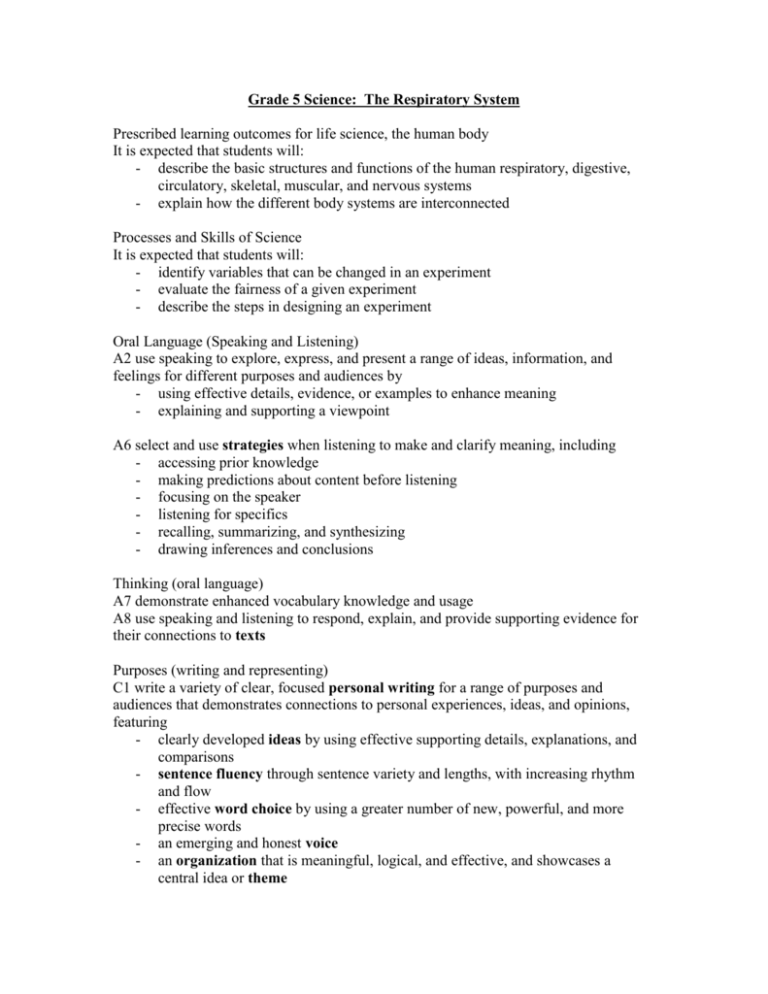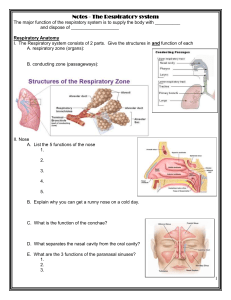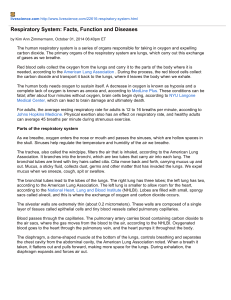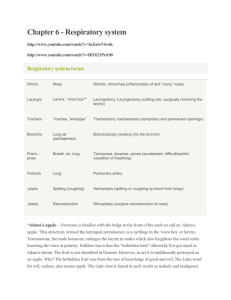Grade 5 Science: The Respiratory System
advertisement

Grade 5 Science: The Respiratory System Prescribed learning outcomes for life science, the human body It is expected that students will: - describe the basic structures and functions of the human respiratory, digestive, circulatory, skeletal, muscular, and nervous systems - explain how the different body systems are interconnected Processes and Skills of Science It is expected that students will: - identify variables that can be changed in an experiment - evaluate the fairness of a given experiment - describe the steps in designing an experiment Oral Language (Speaking and Listening) A2 use speaking to explore, express, and present a range of ideas, information, and feelings for different purposes and audiences by - using effective details, evidence, or examples to enhance meaning - explaining and supporting a viewpoint A6 select and use strategies when listening to make and clarify meaning, including - accessing prior knowledge - making predictions about content before listening - focusing on the speaker - listening for specifics - recalling, summarizing, and synthesizing - drawing inferences and conclusions Thinking (oral language) A7 demonstrate enhanced vocabulary knowledge and usage A8 use speaking and listening to respond, explain, and provide supporting evidence for their connections to texts Purposes (writing and representing) C1 write a variety of clear, focused personal writing for a range of purposes and audiences that demonstrates connections to personal experiences, ideas, and opinions, featuring - clearly developed ideas by using effective supporting details, explanations, and comparisons - sentence fluency through sentence variety and lengths, with increasing rhythm and flow - effective word choice by using a greater number of new, powerful, and more precise words - an emerging and honest voice - an organization that is meaningful, logical, and effective, and showcases a central idea or theme Features (writing and representing) C9 use writing and representing to extend thinking by - developing explanations - expressing alternative opinions or perspectives - exploring new ideas (e.g., expressing an unfamiliar viewpoint) C11 use the features and conventions of language to express meaning in their writing and representing, including - complete simple and compound sentences and begin to use complex sentences Part One: Assessment Overview Table Assessment Tasks Summative 1. KWL Chart 2. Questions from the textbook 3. Worksheets and diagrams from a different text 4. Lung Experiment 5. Unit Test Formative 1. KWL Chart (before and after the unit) PLO Link A2, A6 C1, C9, C11 Logical, verbal/linguistic Logical, verbal/linguistic C9 Kinesthetic, verbal/linguistic A6, A8, C9, and Processes and Skills of Science PLO Kinesthetic, logical, Verbal/linguistic C1, C9, C11 and Describe the basic Logical, linguistic A2, A6, A7, A8 N/A 2. Ask questions while reading the text as a class, and have class discussions with topics such as lung cancer A2, A6 3. Questions from the textbook C1, C9, C11 4. The Respiratory System Worksheets/diagrams Multiple Intelligence C9 5. Lung experiment and follow-up worksheet A6, A8, C1, C9 6. Teacher reviews vocabulary, and unit before exam – play jeopardy afterwards to quiz them A6, A7, A8 7. Test Diagnostic 1. KWL Chart 2. Elements of an experiment, purpose C1, C9, C11 N/A N/A Part 2: Task Analysis Description of Performance-Based Summative Task An introductory script before the experiment would read as follows: Teacher: “Let’s review, what is the function of the lung?” Student: “To help you breathe” Teacher: “Very good. Today we are going to make a ‘human lung.’ You will be able to see what the functions of the different parts of the lung do, and what happens to your lungs when you breathe in and out. While you were at recess I put all of your materials on your desk. After the experiment I will give you a handout, and you will have to answer a few questions about the experiment. You can discuss them with your partner after they are done, then you will hand them in. The instructions are on the board. Please follow me as I do it and do not jump ahead. On the board, steps to the experiment: 1) With your scissors, cut the bottom of the plastic bottle (teacher models) 2) cover bottom part of the bottle with the saran wrap and put an elastic around it (teacher models) 3) insert balloon in the mouth of the bottle with the end of the balloon covering the top of the bottle (teacher models) 4) Pinch the saran wrap and pull it gently down, what do you see? Now push it back up, what do you see? 5) Discussion questions: What do you think the bottle represents? What do you think the balloon represents? What does the saran wrap represent? Teacher hands students worksheet after discussion. Then the students discuss with their partner the answers and hands them in. Students afterwards put their ‘lung’ in the backpacks to show their parents. Rubric for Performance-Based Summative Task Grade 5 – Oral Language (Speaking and Listening) Criteria Speaking& Listening Purposes 1. Students are able to provide a clear and relevant prediction or guess. Purposes 2. Students follow instructions from teacher and board. Thinking 3. Students can summarize and synthesize by answering the questions on their worksheet successfully, and label the diagram based on the experiment. Approaching Expectations (C-) Meeting Expectations (C+) Exceeding Expectations (A) Rarely Most of the Time All of the time Rarely Most of the Time All of the time Rarely Most of the Time All of the time Objective/Subjective Instrument The following unit test consists of both objective and subjective tasks. Before students begin the exam explicit directions will be provided regarding the expectations to the answers. All the answers must be written in full sentences. Students are to read the exam carefully, and to make sure they write down the five things if five things are asked in the questions, or three, and so forth. Respiratory System Test 1. What is the function of the respiratory system? (1 mark) _____________________________________________________________________ _____________________________________________________________________ _____________________________________________________________________ 2. Name 5 parts of the respiratory system? (5 marks) _____________________________________________________________________ _____________________________________________________________________ 3. How does the air enter your body? (1 mark) _____________________________________________________________________ _____________________________________________________________________ _____________________________________________________________________ 4. What is worse, first hand or second hand smoking? Why? (2 marks) _____________________________________________________________________ _____________________________________________________________________ _____________________________________________________________________ 5. Why do you think smoking has been banned in many public buildings? (2 marks) _____________________________________________________________________ _____________________________________________________________________ _____________________________________________________________________ _____________________________________________________________________ _____________________________________________________________________ 6. What is the gas that is exchanged for oxygen in the lungs called? (1 mark) _____________________________________________________________________ _____________________________________________________________________ 7. What is the purpose of the diaphragm? (1 mark) _____________________________________________________________________ _____________________________________________________________________ 8. List three ways in which you can keep your respiratory system healthy. (3 marks) _____________________________________________________________________ _____________________________________________________________________ _____________________________________________________________________ _____________________________________________________________________ Multiple Choice – 1 mark per question 1. Air is inhaled through the ____________, where it is filtered, warmed, and moistened. a) lungs b) brain c) nose d) mouth 2. The ________________ is a flap of tissue at the top of the larynx. It prevents food from entering the windpipe by covering the larynx when food is swallowed. a) epiglottis b) oxygen c) larynx d) alveoli 3. The ________________ is a dome-shaped muscle found under the rib cage which assists during inhaling and exhaling. a) capillaries b) diaphragm c) pharynx d) carbon dioxide 4. In each of the two lungs, the bronchi divide into smaller branches which contain millions of tiny air sacs called ___________. a) exhale b) trachea c) bronchial tube d) alveoli 5. From the nose, air then passes through the __________, which is the area behind the nose that leads to the throat. a) larynx b) vocal cords c) pharynx d) trachea Total marks:____/21 Respiratory System Test: Answer Key Short answer questions. (all are to be in full sentences) 1. The purpose of the respiratory system is to exchange the gases of oxygen and carbon dioxide. The respiratory system also helps you breathe. * more advanced answer – The function of the respiratory system is to carry the air to the lungs where the exchange of gas occurs. 2. Five parts of the respiratory system are the larynx, pharynx, epiglottis, trachea and diaphragm. 3. Air enters the body through the nose and mouth. 4. Second hand smoking is worse because those around the person smoking breathe in more of the smoke. Smoking causes lung cancer to both first hand and second hand smokers. **Answers may vary, as was discussed in class. 5. Smoking has been banned in many public buildings because some people are allergic to smoke, and it causes lung cancer, and heart disease. Also, breathing in smoke is worse than smoking itself. **Answers may vary. 6. The gas that is exchanged for oxygen in the lungs is called carbon dioxide. 7. The diaphragm helps you breathe. It is a dome-shaped muscle found under the rib cage which helps during inhaling and exhaling. 8. Three ways in which you can keep your respiratory system healthy are by exercising, not breathing in smoke, and eating healthy. **Answers may vary Multiple Choice answers: 1. 2. 3. 4. 5. c a b d d Behavior Content Matrix PLOs 1 2 3 4 5 6 A7 C9 Total Marks for Blooms 1 5 1 10 X 3 X 1 X X X X Total Marks for each PLO 2 19 6 11 3 1 X X 21






